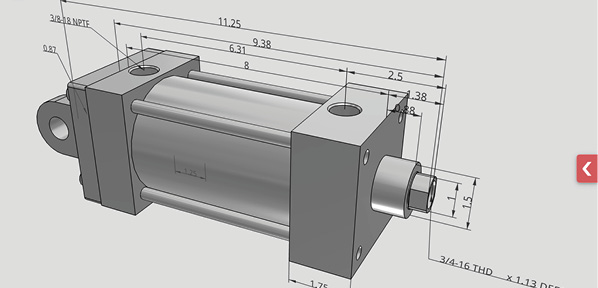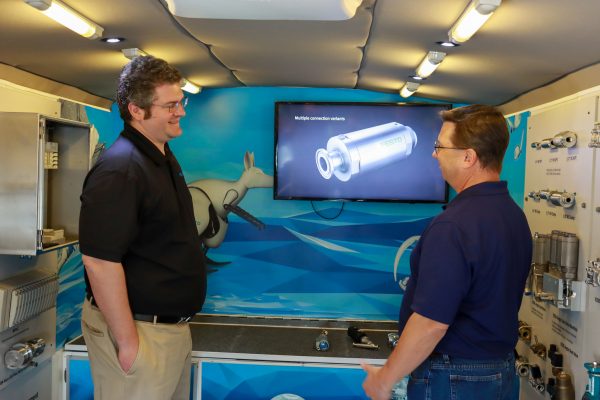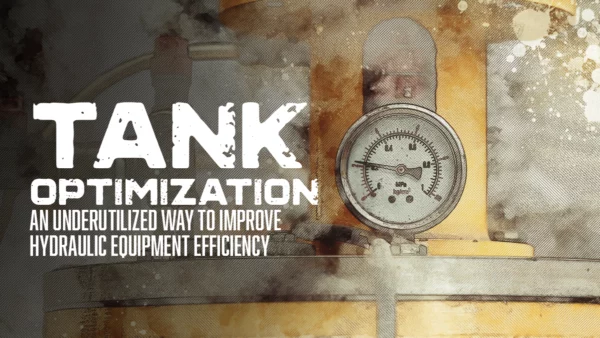Integrating the Hydraulic Filter Catridge on the Manifold: Can It Work?

By Gordon Weiler, Vice President of Sales, Daman Products.
Traditionally, adding a filter to a hydraulic system has meant plumbing an inline filter housing as a stand-alone component that is not integrated as part of the main manifold portion of the system. This separation of components has resulted in excessive plumbing, labor, and leak points associated with failing to consider an integrated solution that minimizes the number of components and improves overall system efficiency.
Stationary industrial applications benefit the most from integrating filter cartridges into a manifold. Larger systems in the press, oil and gas, metals, recycling, power generation, and renewable energy industries traditionally require fabricated freestanding structures on the hydraulic power unit to securely mount the filter housings. An integrated filter cartridge solution eliminates the time, labor, and space typically required for such projects. In addition, the elimination of the filter head significantly reduces the overall production cost, as 80% of the traditional filter solution cost comes from the filter head.
Mobile markets also benefit from integrated filter cartridge manifolds in material handling, agricultural, railroad, mining, aerospace, and construction applications that have tight physical constraints and strict weight requirements. Integrating the filter cartridge directly into the existing manifold saves valuable space and reduces the overall weight of the system. This improves pressure-drop characteristics in these low-flow applications that cannot afford to sacrifice performance.
Shifting from traditional filter systems
All hydraulic applications require filtration to maximize performance and component longevity. Traditionally, these systems have included a filter cartridge component located inside the filter bowl that is screwed into a filter housing. The manifold is a staple of most hydraulic systems and is designed to improve circuitry efficiency.
 By reimagining the traditional filter solution and machining the filter cartridge cavity directly into the existing manifold, the external filter housing can be completely eliminated. With this approach, the traditional filter housing and mounting structure, and all plumbing and associated fittings, are no longer necessary. The new location of the filter directly on the manifold brings the structure closer to the reservoir and hydraulic pump portion of the system, which maximizes efficiency and reduces required plumbing components.
By reimagining the traditional filter solution and machining the filter cartridge cavity directly into the existing manifold, the external filter housing can be completely eliminated. With this approach, the traditional filter housing and mounting structure, and all plumbing and associated fittings, are no longer necessary. The new location of the filter directly on the manifold brings the structure closer to the reservoir and hydraulic pump portion of the system, which maximizes efficiency and reduces required plumbing components.
Manifold-integrated filter cartridges are not a new concept to fluid power. By removing the cartridge and bowl from the filter housing, innovative fluid power professionals have determined how to machine the complex filter-cartridge cavity directly in the manifold as a one-off custom solution. This process of machining the cartridge cavity is complex, requiring expensive tooling and even more expensive measuring equipment to produce a high-quality solution.
While machining a one-off manifold with makeshift tooling and questionable quality control is feasible, the resulting process is not sustainable for long-term production. To truly accomplish sustainable change and encourage mainstream adoption, manufacturers should consider investing in a full-line, comprehensive capital expenditure of tooling and measuring equipment. This investment develops a customized approach into a standard offering, allowing all stakeholders to benefit from the efficiencies achieved by standardization. While manufacturers and distributors may hesitate to take on upfront production costs, providing integrated components can result in a return on investment throughout the supply chain by offering longer component life cycles and reduced maintenance costs due to better performance and fewer malfunctions.
Advantages
Let’s look at some of the advantages of an integrated filter cartridge solution.
Improved flow and pressure-drop characteristics. Traditional filter housing solutions typically use a standard housing size that can accommodate up to four different size filters. This allows filter manufacturers to reduce material inventory by supporting multiple filter sizes with one single material blank. While this is efficient from a manufacturing standpoint, there are two main disadvantages to this approach. The first is that the smallest filter size in a family will be machined to a blank larger than what is required, adding unnecessary weight and taking up valuable space. The second disadvantage is that the largest filter size in a family is crammed into a blank that is not large enough to maximize drillings and optimize flow and pressure-drop characteristics. Integrating the filter cartridge into the existing manifold allows the manifold designer to maximize drill sizes in accordance with a specific filter size and flow requirements without the above-mentioned limitations. More direct connections can be made with larger drill passages, as the manifold material size becomes a design advantage not a limitation. Flow and pressure-drop improvements are inherent to the integration, and the clog indicator valve can be placed anywhere on the manifold to best suit the application.
Reduced assembly time with fewer components. With the integration of the filter housing into the manifold, the long plumbing no longer runs to and from the filter stand, thus eliminating the need for elbows, tees, and fittings. The solution also eliminates the fabricated structure required to support the filter housing, leading to significant labor and cost savings.
Reduced leak points. As a result of the integrated filter, the cartridge and bowl screw directly into the manifold. All filter connections are drilled within the manifold itself, eliminating the plumbing associated with a traditional solution. The traditional plumbing adds two possible leak points, whereas the integrated manifold solution adds only one, where the bowl screws into the manifold cavity. All other connections are made within the manifold itself.
A more compact design. Traditional tank line filter housing solutions must be mounted on or near the hydraulic reservoir, requiring space accommodations. Integrating the filter cartridge and bowl into the existing manifold eliminates the traditional filter housing component, saving valuable space. Similarly, the traditional pressure filter solution saves even more space on the hydraulic power unit by eliminating the fabricated structure, pressure line plumbing, and filter head, as mentioned above.
Improved field maintenance serviceability. Integrating a filter cartridge into the manifold eliminates long plumbing runs, elbows, adaptors, hose clamps, and a number of other possibilities for leaks and plumbing failures. Any qualified hydraulic maintenance professional will confirm that reduced fitting and plumbing in a hydraulic system reduces the potential for system failure. As a result, integrated filter cartridge solutions simplify the maintenance process, resulting in easier service.
Reduced costs. Integrated filter solutions drastically reduce the overall costs associated with traditional filter solutions. While typical methods involve procuring and assembling plumbing, fittings, fab structures, and filter heads, the integrated filter solution manages to bypass all the traditional filter costs. Instead, the filter cartridge and bowl screw directly into the manifold, resulting in a quick, easy, and cost-effective assembly. The combination of hydraulic cartridge valves with an integrated filter offers the hydraulic system designer more flexibility in applying filtration products. The designer can use check valves, flow control, and pressure-control valves to protect the filter from hydraulic shock and flow surges. In some cases, you can use a single integrated filter in place of two traditional filters.
Decreased hydraulic component footprint. The most efficient power units are equipped with a custom integrated manifold that occupies a certain amount of space within the system. Instead of adding unnecessary bulk to the system, the existing manifold can be used to communicate pressure and flow directly to the filter cartridge bowl as an integrated solution. By reimagining the traditional filter housing solution as an integrated system, manufacturers can reclaim valuable space inside the manifold, reducing their hydraulic footprint.
Reduced lead times. Integrated custom solutions are synonymous with long lead times. However, integrating filter cartridge solutions into existing custom manifolds actually reduces overall lead times. In years past, the most innovative hydraulic professionals accepted the longer lead times associated with integration to reap the benefits of a superior solution. As custom manifolds have become increasingly popular, manufacturers have tooled up to support the shorter lead-time needs of the custom manifold markets. While lead times for custom solutions are becoming shorter, this has not been the case with filter cartridge solutions, which are notorious for long lead times. Tooling costs to machine and accurately inspect the cavity can run between $8,000 and $12,000. Add to that the number of different sizes required and manufacturers involved. Capital expenditures can easily exceed $500,000. While a significant investment, simply having on-site filter cavity tooling allows manufacturers to produce these manifolds as quickly as any other custom solution, removing the primary roadblock to quickly and efficiently producing filter cartridge solutions.
In a customer survey, Daman Products asked manifold distributors about the perceived benefits of an integrated filter cartridge solution. The responses were overwhelmingly positive, with the majority of distributors agreeing that an integrated filter solution would be extremely beneficial to the industry. “Standard filter housings have limited pressure and flow characteristics based on the standard housing casting availability,” one manufacturer said. “As a custom, specific drillings can be used to improve flow characteristics and pressure drops.”
Another distributor said the solution is helpful to customers because it “reduces connection points,” resulting in a more fluid design and ultimately a higher-performing product.
With positive feedback from distributors and years of experience machining filter cartridge cavities, Daman Products invested in filter cartridge-specific tooling to test whether having in-house tooling would improve lead times for filter cartridge projects. With the necessary in-house tooling, Daman demonstrated reduced lead times for all filter cartridge solutions, improving distributor satisfaction and peace of mind.
Optimizing performance
Fluid power professionals are always looking for ways to improve hydraulic systems through the integration of components to simplify machines, improve performance, eliminate leak points, and minimize maintenance issues. These benefits provide cost savings and the pure efficiency of directly integrating critical components.
Integrating circuit functionality into hydraulic pumps and cylinder heads eliminates the need to plumb to a separate valve body. Electric motion control solutions have been integrated with hydraulic actuation components, resulting in improved motion control and automation while reducing the number of overall components.
With the newfound ease of hydraulic circuitry customization and the fluid power industry’s dedication to integrate wherever possible, engineers with filter cartridge experience can leverage their knowledge of the complete machine circuit to their advantage. By adding filter integrated cartridges and any other desired cartridge valves directly into the existing manifold circuit, engineers achieve a completely holistic hydraulic circuit that optimizes every possible component within the manifold.
The integration of the filter cartridge directly into the manifold is an industry game-changer, allowing engineers to freely innovate their solutions without compromising the integrity of the overall design. As history continues to prove, the most creative solution is the key to future success, and filter cartridge integration is no exception.







